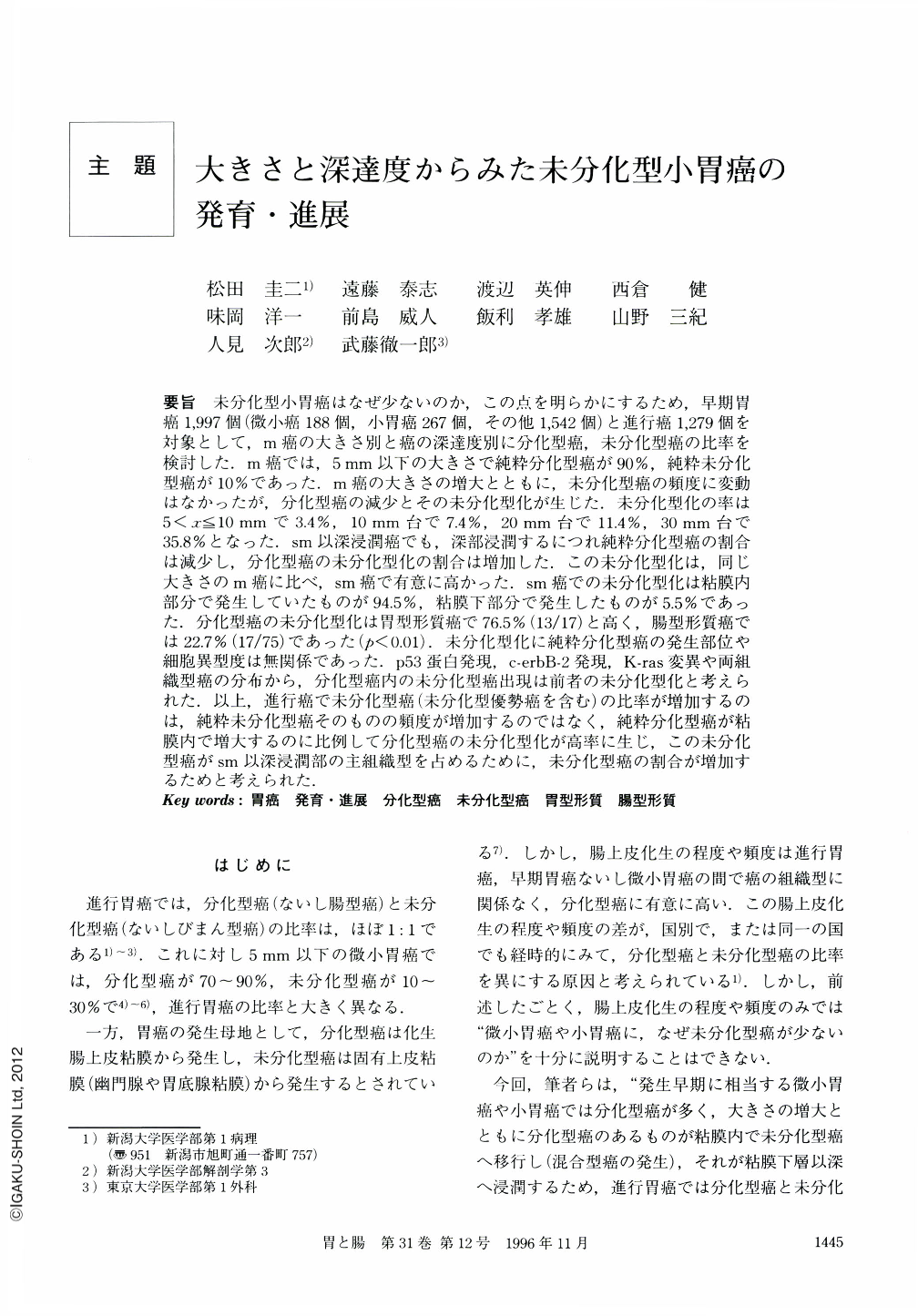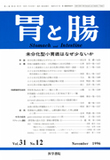Japanese
English
- 有料閲覧
- Abstract 文献概要
- 1ページ目 Look Inside
- サイト内被引用 Cited by
要旨 未分化型小胃癌はなぜ少ないのか,この点を明らかにするため,早期胃癌1,997個(微小癌188個,小胃癌267個,その他1,542個)と進行癌1,279個を対象として,m癌の大きさ別と癌の深達度別に分化型癌,未分化型癌の比率を検討した.m癌では,5mm以下の大きさで純粋分化型癌が90%,純粋未分化型癌が10%であった.m癌の大きさの増大とともに,未分化型癌の頻度に変動はなかったが,分化型癌の減少とその未分化型化が生じた.未分化型化の率は5<x≦10mmで3.4%,10mm台で7.4%,20mm台で11.4%,30mm台で35.8%となった.sm以深浸潤癌でも,深部浸潤するにつれ純粋分化型癌の割合は減少し,分化型癌の未分化型化の割合は増加した.この未分化型化は,同じ大きさのm癌に比べ,sm癌で有意に高かった.sm癌での未分化型化は粘膜内部分で発生していたものが94.5%,粘膜下部分で発生したものが5.5%であった.分化型癌の未分化型化は胃型形質癌で76.5%(13/17)と高く,腸型形質癌では22.7%(17/75)であった(ρ<0.01).未分化型化に純粋分化型癌の発生部位や細胞異型度は無関係であった.p53蛋白発現,c-erbB-2発現,K-ras変異や両組織型癌の分布から,分化型癌内の未分化型癌出現は前者の未分化型化と考えられた.以上,進行癌で未分化型癌(未分化型優勢癌を含む)の比率が増加するのは,純粋未分化型癌そのものの頻度が増加するのではなく,純粋分化型癌が粘膜内で増大するのに比例して分化型癌の未分化型化が高率に生じ,この未分化型癌がsm以深浸潤部の主組織型を占めるために,未分化型癌の割合が増加するためと考えられた.
Why are small undifferentiated-type gastric carcinomas a few `? To elucidate the reasons, we studied the frequency of pure differentiated-type (D-type), pure undifferentiated-type (U-type) and mixed type (D- and U-type) carcinomas by tumor size of intramucosal carcinomas and by depth of cancer invasion, using 1,997 early cancers (188 microcarcinomas measuring 5 mm or less,267 small carcinomas 5<x≦10mm sized, and 1,542 cancers above 10mm in size) and 1,279 advanced cancers.
Ninety% of intramucosal microcarcinomas were comprised of pure D-type carcinomas, and 10% were comprised of pure U-type carcinomas. The former decreased and underwent transformation to U-type with the size of cancer, but the frequency of pure U-type carcinomas did not change with the size. The frequency of transformation from D-type to U-type was 3.4% in 5<x≦10mm-sized tumors, 7.4% in the 10<x≦20mm tumors, 11.4% in the 20<x≦30mm tumors and 35.8% in the 30mm<x tumors. With the depth of carcinoma invasion, pure D-type carcinomas decreased in rate and the rate of transformation of D-type to U-type increased, but pure U-type carcinomas did not show a significant change in frequency. The transformation rate was significantly higher in the mucosal area of submucosal carcinomas than in mucosal carcinomas even when the tumors were the same size. The transformation of submucosal cancer started in the mucosal area in 94.5% of the cases, and in the submucosal area only in 5.5% of the cases. The transformation was significantly higher in carcinomas with gastric phenotype (76.5%, 13/17) than in carcinomas with intestinal phenotype (22.7%, 17/75) (p<0.01), but had no correlation with location or cytological atypia of pure D-type carcinomas. U-type and D-type carcinomas in mixed-type carcinomas were mixed in their distribution, and almost the same in p53 protein expression, c-erbB-2 expression and K-ras mutation.
These findings suggest that intramucosal D-type carcinoma transforms itself into U-type carcinoma with increase in its size, and that the latter easily invades the submucosa to form the main histological type of invasive area.

Copyright © 1996, Igaku-Shoin Ltd. All rights reserved.


